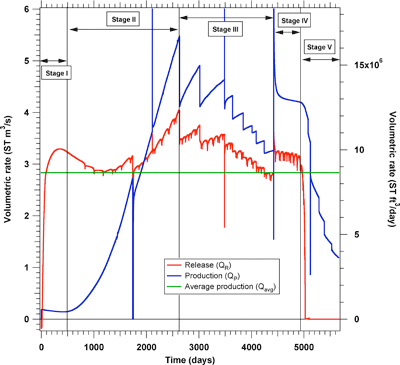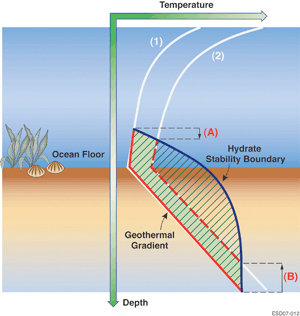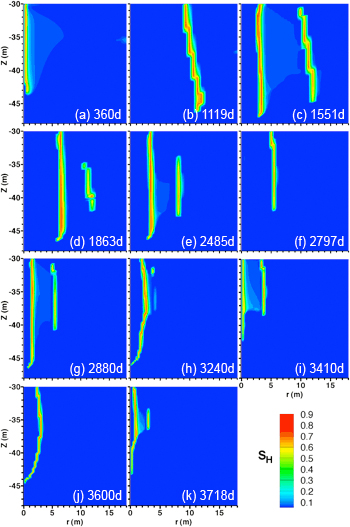Summary
TOUGH+ is the result of a re-engineering effort in which the capabilities of TOUGH2 have been recast in a modular design that adheres to the tenets of object-oriented programming as implemented in Fortran 95. New capabilities have been added. I particular, the range of thermodynamic properties of water has been extended to include ice for the modeling of freezing and thawing in permafrost regions, and – specifically – for the simulation of processes in hydrate-bearing sediments, which involve. formation and dissociation of ice-like hydrates with associated changes in porosity, permeability, and two-phase flow characteristics. The first modules released in the new framework are TOUGH+Hydrate and TOUGH+RealGasBrine for the simulation of these processes in hydrate- and gas-bearing formations. TOUGH+ maintains backwards compatibility with TOUGH2 input files.
Features & Capabilities
TOUGH+ solves mass and energy balance equations that describe fluid and heat flow in general multiphase, multicomponent, porous-media systems. TOUGH+ can model the following processes and phenomena in geologic systems:
- The partitioning of the mass components among the possible phases
- The flow of gases and liquids in geologic media
- The corresponding heat flow and transport
- Heat exchanges due to
- Conduction
- Advection/convection
- Radiation
- Latent heat related to phase changes
- Gas and inhibitor dissolution
- The transport of water-soluble gases and solutes (such as salts and alcohols, if included in the properties model), accounting for advection and molecular diffusion
When using the HYDRATE properties module:
- Equilibrium or kinetic hydration reaction
- The effects of water-soluble inhibitors on the hydrate behavior
- Any method of hydrate dissociation (i.e., depressurization, thermal stimulation and inhibitor effects), and combinations thereof
A deliberate effort was made to keep the simplifying assumptions involved in the development of the underlying physical, thermodynamic and mathematical model to a minimum. The assumptions used include:
- Darcy’s law is valid in the simulated domain under the conditions of the study
- In the transport of dissolved gases and inhibitors, mechanical dispersion is small compared to advection
- The movement of the geologic medium (for example soil heaving while freezing) is not described, and the effects on pressure are accommodated through a relatively high pore compressibility of the geologic medium (external coupling to external geomechanics software is supported)
- Dissolved salts do not precipitate as their concentration increases; consequently, the aqueous phase is not allowed to disappear when salts are present
- The concentration of the dissolved species is such that it does not affect the thermophysical properties of the aqueous phase
- The pressure remains below 100 MPa (14,500 psi).
A detailed description of the constitutive equations used in TOUGH+ can be found in the TOUGH+Hydrate Users Guide.
TOUGH+ maintains backward compatibility with TOUGH2 input files and input conventions, while also providing new user features such as dynamic memory allocation and modern memory management, enhanced meshing capabilities, namelist-based input designations, improved labeling of input and output files, and the option of coupling to commercial geomechanical simulators.
TOUGH+ has been validated and verified through comparison to different analytical and numerical solutions, laboratory results, and data from field-scale experiments.
Applications
Gas Production from Oceanic Class 2 Hydrate Deposits
George J. Moridis and Matthew T. Reagan
 Class 2 hydrate deposits comprise two zones: a hydrate-bearing layer overlying a zone of mobile water. The objective of this study is to evaluate the production potential of marine Class 2 methane hydrate accumulations by means of numerical simulation, and to develop appropriate strategies for gas production. The simulated system is based the “Tigershark” area, located in the Gulf of Mexico. We use a 2-D radial mesh representing the hydrate deposit, underlying aquifer, and impermeable shale boundaries. Production simulations were performed using TOUGH+Hydrate. Depressurization-induced dissociation was selected as the most promising gas production strategy because of its simplicity and its technical and economic effectiveness.
Class 2 hydrate deposits comprise two zones: a hydrate-bearing layer overlying a zone of mobile water. The objective of this study is to evaluate the production potential of marine Class 2 methane hydrate accumulations by means of numerical simulation, and to develop appropriate strategies for gas production. The simulated system is based the “Tigershark” area, located in the Gulf of Mexico. We use a 2-D radial mesh representing the hydrate deposit, underlying aquifer, and impermeable shale boundaries. Production simulations were performed using TOUGH+Hydrate. Depressurization-induced dissociation was selected as the most promising gas production strategy because of its simplicity and its technical and economic effectiveness.For all strategies, production at the well is characterized by distinct cycles (see figure), with the end of each cycle marked by cavitation (rapid pressure drop at the well) caused by either secondary hydrate blockages near the well or by the increasing participation of lower-density gas. This is remedied by warm seawater injection and a reduction in the total mass production rate. Gas production continuously increases during each cycle, with a corresponding reduction in the water production.
The most effective production strategy used a combination of electrical heating to initiate production, warm seawater circulation during continued production, and the application of a novel well design that combines warm seawater injection with a long production interval to access the remaining hydrate and avoid blockages and cavitation (see the related publication). This approach is clearly superior to conventional production techniques for production under the Tigershark reference conditions, and demonstrates that gas can be produced at high rates over long periods from Class 2 oceanic hydrate deposits using conventional technology.
The figure shows rates of (a) hydrate-originating CH4 release in the reservoir (red) and (b) CH4 production at the well (blue) during production from a Class 2 oceanic hydrate deposit. The stages of production and the average production rate (Qavg, in green) over the simulation period are also shown.
Reference
- Moridis, G.J. and M.T. Reagan, Gas Production From Oceanic Class 2 Hydrate Accumulations, LBNL-62757, OTC 18866, 2007 Offshore Technology Conference, Houston, Texas, U.S.A., 30 April–3 May 2007.
Gas Production from Oceanic Class 3 Hydrate Deposits
George J. Moridis and Matthew T. Reagan
Class 3 hydrate accumulations are composed of a single zone of methane hydrate bounded by confining strata with no underlying zone of mobile fluids. Early production attempts using thermal stimulation suggested these formations as poor targets for gas production. A new strategy, simulated using TOUGH+HYDRATE, uses constant-pressure production to overcome the very low initial effective permeability of the deposit and the lack of a zone of mobile fluids.
The simulated gas production occurs in a cyclical pattern. Each cycle consists of a long stage of increasing gas production, followed by sharp production decline, followed by a recovery. This pattern is repeated until the cessation of production. Peak production regularly exceeds 5 ST m3/s of CH4 (15 MMSCFD), and the average gas production during the 6000-day simulation period is 2.61 ST m3/s (8.10 MMSCFD). Recovery from each production decline occurs naturally, without heating or fluid injection.
The figure shows the evolution of the spatial distribution of hydrate saturation over time, and provides an explanation for the cyclical pattern. The precipitous drops in production are caused by the evolution of traveling barriers of secondary hydrate around the well. As gas flows to the well, a cylindrical sheath of secondary hydrate forms next to the wellbore (Panel A). Because the inner radius of the barrier is exposed to intense depressurization, it dissociates, but additional hydrate forms on its outer radius, resulting in the appearance of a traveling barrier (B). A second barrier forms (C) and moves outward through the same process (D). The outer barrier is now shielded from steep pressure gradients, and dissociates (D through F). New barriers appear and disappear (G though K) over time. Each of the temporary drops in production occur when a new inner secondary hydrate barrier is formed.
This simulation demonstrates that large volumes of natural gas can be produced at high rates over long periods from Class 3 oceanic hydrate deposits using straightforward depressurization-induced dissociation. Hence, these deposits may be viable candidates for future exploitation and development.
The figure shows the evolution of spatial distribution of hydrate saturation, SH, during gas production from a Class 3 oceanic hydrate deposit, showing the traveling barriers of secondary hydrate.
Reference
- Moridis, G.J. and M.T. Reagan, Strategies for Gas Production From Oceanic Class 3 Hydrate Accumulations, LBNL-62758, OTC 18866, 2007 Offshore Technology Conference, Houston, Texas, U.S.A., 30 April–3 May 2007.
Oceanic Gas Hydrate Instability and Dissociation Under Climate Change Scenarios
Matthew T. Reagan and George J. Moridis
 The amount of methane hydrate currently residing in the deep ocean and along continental margins is estimated to be from 500 billion to over 3,000 billion tons. The dissociation of accumulated oceanic gas hydrate deposits and the release of large quantities of methane—a powerful greenhouse gas—in a short period of time could have dramatic climatic consequences, leading to positive climate feedbacks. Using TOUGH+Hydrate, we simulated the response of several types of oceanic gas hydrate accumulations to temperature changes at the seafloor and assessed the potential for methane release into the ecosystem.
The amount of methane hydrate currently residing in the deep ocean and along continental margins is estimated to be from 500 billion to over 3,000 billion tons. The dissociation of accumulated oceanic gas hydrate deposits and the release of large quantities of methane—a powerful greenhouse gas—in a short period of time could have dramatic climatic consequences, leading to positive climate feedbacks. Using TOUGH+Hydrate, we simulated the response of several types of oceanic gas hydrate accumulations to temperature changes at the seafloor and assessed the potential for methane release into the ecosystem.
We modeled oceanic hydrate deposits, represented as 1-D columns, under a range of depths and temperatures using the TOUGH+HYDRATE code. We simulated temperature increases of 1 °C to 5 °C over a 100 yr period, representing possible changes in seafloor temperature as predicted by climate simulators, and determined the fate of the hydrate deposits and tracked the transport of released methane to the seafloor.
These results indicate that while many deep oceanic hydrate deposits are stable under the influence of significant temperature variations, shallow deposits, such as those found in arctic regions or in the Gulf of Mexico, can undergo rapid dissociation and release large quantities of carbon. In arctic regions in particular, temperature changes are expected to be more pronounced, increasing the risk of hydrate destabilization even further. These simulations will provide a source term to global climate models, yielding a prediction of the possible effects of oceanic hydrate decomposition on global climate.
References
- Reagan, M.T. and G.J. Moridis, Oceanic Gas Hydrate Instability and Dissociation Under Climate Change Scenarios, Geophys. Res. Lett., 34, L22709, doi: 10.1029/2007GL031671, 2007.
- Reagan, M.T. and G.J. Moridis, The dynamic response of oceanic hydrate deposits to ocean temperature change, J. Geophys. Res. Oceans, doi:10.1029/2008JC004938, 2008.
Awards & Recognition
- Charting the Future of Methane Hydrate Research in the United States, report by the National Research Council: “LBNL Hydrate Modeling: a Small Project with a Major Technology Impact”
- LBNL Tech Transfer Award, 2005
- Featured articles:
- Journal of Petroleum Technology, August 2007
- Journal of Petroleum Technology, July 2008
- American Oil and Gas Reporter, 2008 50th Anniversary Issue
